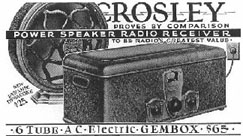

|
The radio was invented in December 11, 1901, by Guglielmo Marconi. He was able to transmit sound waves from England to Newfoundland 3440 km away. Radio played a very vital role in signaling for help in 1912 when the Titanic sank. Modern technology made the radio accessible to the masses. | |
 "Our radio station has been an important link of communication in aiding distressed vessels and in securing assistance in case of sickness, injuries and death." --R.F. Crittendon, 1926. |
There are two different types of radio waves namely audio frequency and radio frequency. Transmitted sounds are called radio waves while waves that 'transports' the audio information is called radio frequency. A transmitter picks up the waves mentioned above and converts these waves into electric indicators. The frequency is then transformed into a reduced level, which is stable throughout. Signals are made stronger and they are separated by through an amplifier and demodulator respectively. |
|
They began to experiment with a set of headphones, a tiny transmitter and a receiving unit. They started off with sending the Morse code before proceeding on to add sound waves for the ability to transmit voices. The nation's first commercial broadcast station was set up in 1920 after some years of investigating by a man named Thomas E.Clark. It helped to transmit weather reports to the people and also shipping information in the shipping season and also having extra radio shows which provided entertainment: the radio as we know it today. | |
|
The radio was used for many purposes, among them:
|
|